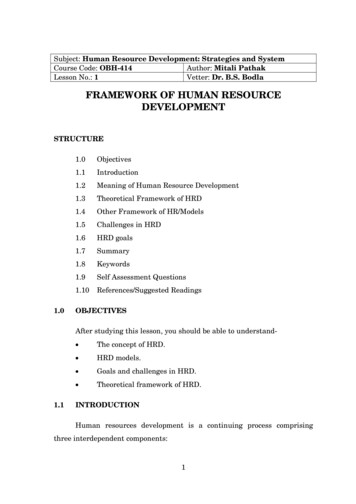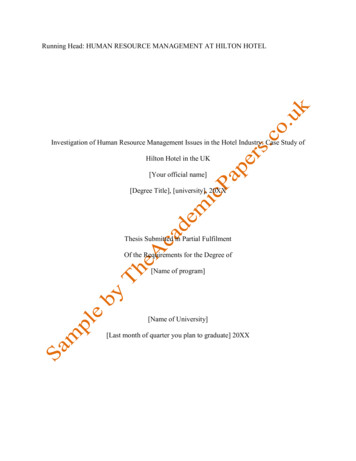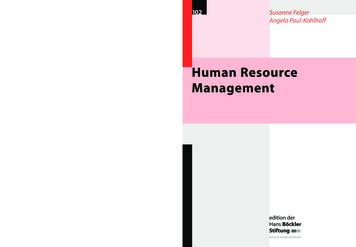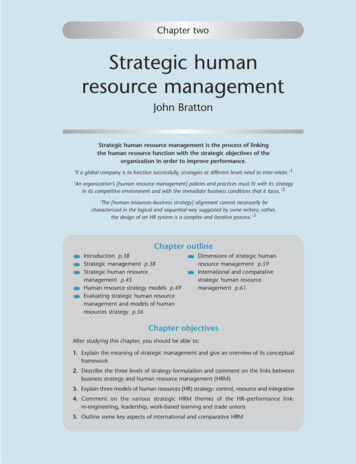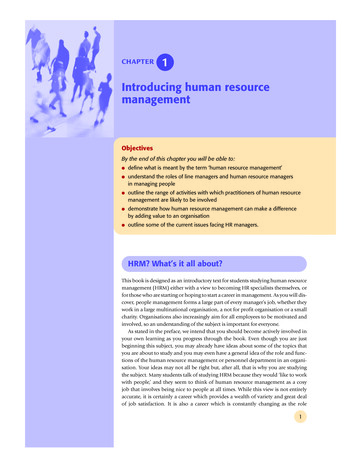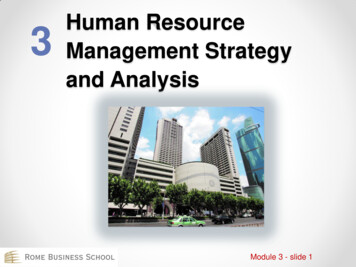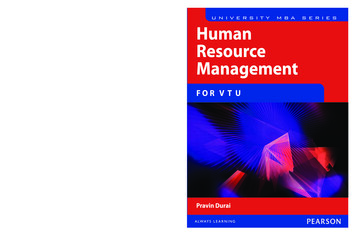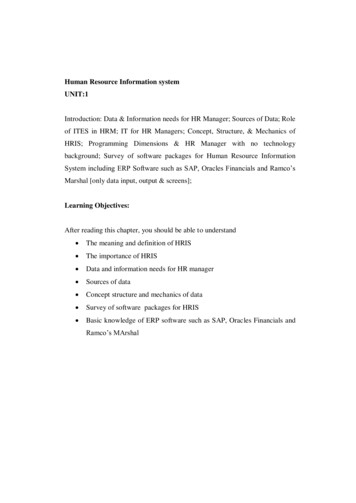
Transcription
Human Resource Information systemUNIT:1Introduction: Data & Information needs for HR Manager; Sources of Data; Roleof ITES in HRM; IT for HR Managers; Concept, Structure, & Mechanics ofHRIS; Programming Dimensions & HR Manager with no technologybackground; Survey of software packages for Human Resource InformationSystem including ERP Software such as SAP, Oracles Financials and Ramco‘sMarshal [only data input, output & screens];Learning Objectives:After reading this chapter, you should be able to understand The meaning and definition of HRIS The importance of HRIS Data and information needs for HR manager Sources of data Concept structure and mechanics of data Survey of software packages for HRIS Basic knowledge of ERP software such as SAP, Oracles Financials andRamco‘s MArshal
IntroductionMany well-known examples of the use of information technology forcompetitive advantage involve systems that link an organization to suppliers,distribution channels, or customers. In general, these systems use information orprocessing capabilities in one organization to improve the performance ofanother or to improve relationships among organizations. Declining costs ofcapturing and using information have joined with increasing competitivepressures to spur numerous innovations in use of information to create value.The ideas do not constitute a procedure leading inexorably to competitiveadvantage. However, they have been of value when combined with anappreciation of the competitive dynamics of specific industries and a grasp ofthe power of information.Results from "The Gap Between IT and Strategic HR in the UK",(June 2006) astudy by talent management solutions company Taleo, show a significantdisconnect between HR's strategic functions, including talent acquisition andworkforce planning, and IT ability to support these business initiatives.The survey of 100 senior HR managers, all in organizations employing morethan a thousand people, found that only a quarter thought that strategicfunctions such as workforce planning, leadership development and performancemanagement were well supported by their IT systems. Only a third feltconfident in systems support for recruitment and employee progression. Otherfindings included: Current technology systems were out-of-date. Over half the respondents(55%) felt that more sophisticated technology systems and processeswere needed to support recruitment and development.
IT focused on lower-level, administrative functions. Respondents saidthat payroll and employee administration (68%) and evaluation andmanagement reporting (53%) were adequately supported by IT.However, more strategic HR initiatives such as performancemanagement (28%), leadership development and planning (25%) andstrategic workforce planning (25%) were not well supported. Inadequate data and technology systems obstructed workforcemanagement. Just 29% of respondents felt that they had sufficientsystems in place to gain a clear picture of existing employee skills. The HR function was striving to become more strategic. 63% ofrespondents cited talent management (including recruitment) as asignificant priority in the year ahead.Taleo Research Vice President, Alice Snell said:"The gap between the support of administrative functions and strategic HRresponsibilities needs to be addressed in order for HR directors to deliver resultsto the Board. When HR directors can assess the workforce changes needed bythe business, acquire and develop the talent needed to optimise the workforce,and then measure the results, their true value can be realised.""Findings of this study clearly show that HR is evolving to play a more strategicrole in supporting fundamental business objectives, but the systems being usedby HR functions are not keeping up," added Neil Hudspith, Senior VicePresident, International Operations, Taleo. "It's clear that talent managementand other strategic initiatives are being recognised as essential functions byambitious companies that want to retain and recruit the best people, butorganisations need to arm their HR directors with the tools and technology
needed to support this strategy. The right HR technology is a critical element ofany HR strategy moving forward."Meaning and Definition of HRISHuman Resources Information System, is a system that lets you keep track ofall your employees and information about them. It is usually done in a databaseor, more often, in a series of inter-related databases.These systems include the employee name and contact information and all orsome of the following:department,job title,grade,salary,salary history,position history,supervisor,training completed,special qualifications,ethnicity,date of birth,disabilities,veterans status,visa status,benefits selected,and more.
Any HRIS include reporting capabilities. Some systems track applicants beforethey become employees and some are interfaced to payroll or other financialsystems. An HRIS is a management system designed specifically to providemanagers with information to make HR decisions You notice that this is not an HR system.it is a management system andis used specifically to support management decision making . The need for this kind of information has increased in the last few years,especially in large and/or diverse companies, where decision making hasbeen moved to lower levels And large companies generally have the advantage when it comes toHRIS‘s.the cost to develop an HRIS for 200 people is usually close tothat for 2000 people.so it is a better investment for largecompanies.larger companies tend to have systems that have a fairdegree of customizationTherefore, HRIS can be defined in simple words as given below.Human Resource Management Systems (HRMS, EHRMS), HumanResource Information Systems (HRIS), HR Technology or also called HRmodules, shape an intersection in between human resource management(HRM) and information technology. It merges HRM as a discipline and inparticular its basic HR activities and processes with the information
technology field, whereas the planning and programming of dataprocessing systems evolved into standardised routines and packages ofenterprise resource planning (ERP) software. On the whole, these ERPsystems have their origin on software that integrates information fromdifferent applications into one universal database. The linkage of itsfinancial and human resource modules through one database is the mostimportant distinction to the individually and proprietary developedpredecessors, which makes this software application both rigid and flexible.Advantages of HRIS An HRIS can reduce the amount of paperwork and manual recordkeeping It retrieves information quickly and accurately It allows quick analysis of HR issuesMost HRIS Contain: Personal history - name, date of birth, sex Work history - salary, first day worked, employment status, positions inthe organization, appraisal data and hopefully, pre-organizationalinformation Training and development completed, both internally and externally Career plans including mobility Skills inventory - skills, education, competencies.look for transferableskills
The pressure is on for proactive HR innovations that contribute directly to thebottom-line or improve employee morale and efficiency. Ajuwon (2002) pointsout that the typical HR professional gets involved with one step in manydifferent flows of work. Very often the involvement of HR has no purposeexcept to validate the process in some way and acts as an interruption to theflow of work. In other words, the HR function is a 'gatekeeper for informationthat‘s been deemed too highly classified for the data owner.'So HR is not actually making a measurable contribution - in fact, the opposite.HR involvement creates a queue or delay in the process. We should ask if theHR involvement is really necessary. Once upon a time the HR database had an'all-or-nothing' quality - probably because it was paper-based. But nowtechnology allows controlled access to various portions of the database. So anemployee can safely amend his or her own address or bank account details,while the ability to change certain appraisal details might be confined to the linemanager. In either case, there is no reason for HR to be involved. HR shouldmove on from the role of intermediary.Not surprisingly, the use of employee self-service systems for records,information, payroll and other functions is becoming increasingly common.Libraries of forms can be kept online to be downloaded as and when required.Systems can be enhanced to include streaming video and other new softwareproviding wide access to corporate videos, training, etc. Obviously, e-mailannouncements and newsletters can also be used to alert employees to newdevelopments or urgent requests.
Ajuwon (2002) argues that HR should be proactive in the process and highlightsthree different perspectives for action:* The process perspective - getting the fundamental building blocks (peopleprocesses) right and ensuring their relevance at all times. This demands closeand detailed knowledge of HR processes and a commitment to improvementand efficiency. HR professionals need to understand their own objectives andthe relationship with business strategy.* The event perspective - a focus on providing a framework for knowledgemanagement. In other words, capturing the experience and informationavailable in that harnesses the organisation and making it available toindividuals.* The cultural perspective - acknowledging that HR has a 'pivotal role in theproactive engagement of the entire organisation in a changing climate.During the 1990s the business process re-engineering approach resulted in manyorganizations taking a 'root and branch' look at HR and other processes.Subsequent reorganizations may have produced fresh, streamlined processes butoften they became inappropriate or inefficient as circumstances changed. It isnot enough to design a corporate human resource strategy or acquire a piece oftechnology. There has to be some way of ensuring effective operationaldelivery. A more fluid, constantly changing methodology is required. Ajuwoncontends that we have the means:"It‘s more than innovating and/or streamlining your HR processes; or buildingan HR portal or introducing a culture change programme.
"It‘s about weaving together all three in a way that sustains change, engages theentire organization and deploys the organization‘s knowledge assets to gaincompetitive advantage and deliver profitability, even in times of economicdownturn."Human resource systems can differ widely. They may be:* Intranets using web-type methods but operating purely within oneorganization or location.* Extranets - encompassing two or more organizations.* Portals - offering links to internal information and services but also accessingthe worldwide tegration (linking different HR systems such as basic personnelrecords, employee handbooks, terms and conditions, contracts, Eliminating printing, enveloping and mailing of personnel and otheremployee-payroll)Allowing employees and managers to enter, check and amend controlledranges-andinformationReducing need for telephone handling of routine enquiries by HR staff.
Basic system requirements1. Desktop PCs for accessing and inputting information locally. Standardbrowsers are used to access information (e.g. Netscape or Internet Explorer).2. Organization-wide server. In a small company this need be nothing more thana PC as well. The server must have an intranet server software package installed(Microsoft Internet Information Server, or Netscape Communications Server areexamples.)3. Server-side software such as HTML, Java, Javascript, Perl.4. Intranet communications protocol running on both PCs and the server.5. Relational database/Information processing software for records, payroll, etc.If data is to be accessed then the procedure is made slightly more complicatedwith the need for CGI scripts and database server software on the server.6. Basic documents such as policy manuals typically loaded in HTML - butformats such as Adobe Acrobat PDF are also an alternative.Cost-benefit analysisDifficult to quantify because the greatest return is in improved morale.Robert Musacchio, CIO with the American Medical Association in Chicago isquoted as having installed between 50-60 intranet applications for 1400employees at 10,000 to 20,000 per application.
"Musacchio says a self-service employee-benefits site, which providesinformation on benefits and lets employees pick health-care, day-care, andretirement investment options, was built for "almost six figures." Musacchiofigures it provided a 40% return on investment, based on the time saved byhuman resource managers who don't have to answer employees' questions aboutthese topics because they're answered by the application".('Intranet ROI: LeapOf Faith',( Information Week Online, May 24 1999.)Fletcher argues that businesses have to adopt a 'Human Capital Management'approach to make the most of any organization's greatest asset: the skills,knowledge and experience of its staff. She describes how, in the 1990s, mostlarge businesses introduced 'Human Resources Information Systems' (HRIS)and that, in combination with re-engineering (the buzzword of the time), thisenabled them to "replace antiquated, time-consuming personnel processes withautomation."Walker (Walker, A.J. 'Best Practices in HR Technology' in Web-Based HumanResources, McGraw Hill, 2001) states that if HR technology is to be consideredsuccessful, it must achieve the following objectives: It must provide the userwith relevant information and data, answer questions, and inspire new insightsand learning.Efficiency and effectivenessHRIS must be capable of changing the work performed by the HumanResources personnel by dramatically improving their level of service, allowingmore time for work of higher value, and reducing their costs.
But, despite extensive implementation of Enterprise Resource Planning (ERP)projects, Human Resource Information Systems (HRIS), and HR service centrescosting millions of dollars, Walker concludes that few organizations have beenentirely happy with the results. Why is this?Many systems have been implemented by cutting HR staff, outsourcing andimposing technology on what was left. Arguably this approach should, at least,have cut costs. But Walker argues that survey results demonstrate that overallHR departments have actually increased their staffing levels over the pastdecade to do the same work. Moreover he considers that:"Most of the work that the HR staff does on a day-to-day basis, such as staffing,employee relations, compensation, training, employee development, andbenefits, unfortunately, remains relatively untouched and unimproved from adelivery standpoint."Fletcher explores the issue of effectiveness in a very telling paragraph (page 15)in which she states that: "Executives struggle with what to measure and how toclearly tie employee metrics to business performance." Not only are theypressured by the vast costs of Human Capital Management (payroll, etc.) butthey also have to report to analysts "whose valuations consist partly ofmeasuring such intangible assets as the corporate leadership's team to executeon strategy or the ability of the business to attract and retain skilled talent."She concludes that: Executives are not sure about the kind of data that would prove toanalysts that their employees are delivering better and creating morevalue than their competitors.
Analysts are struggling to make sense of intangibles, often falling backon a 'revenue per employee' metric which does not tell the whole story.The HR FunctionThe business process should be re-engineering the HR function first, then Eengineering the HR work. He suggests the formation of re-engineering teams ofproviders, customers and users to examine the whole range of HR activities including those which are not being done at present. The end product is a set ofprocesses organized into broad groupings such as resourcing, compensation ortraining and development. These processes should then be examined by the reengineering team and redesigned to: Be better aligned with organizational goals. Streamlined so as to be cost-effective in comparison with the 'best inclass'. Have a better integration with other processes.From this redesign comes the picture of a new HR function. What next? Theorganization could be restructured and the tasks handed out existing or newstaff. But Walker argues that the most effective approach is to introduce newtechnology to deal with the redesigned processes.For HR to survive in this brave new world it needs to "possess a technologyacumen like never before." A tall order, one suspects, for many die-hardpersonnel traditionalists. But if they do not demonstrate the ability torecommend appropriate technology and control automated HR processes,organizations will use other people for these tasks some replacements for'traditional' HR executives may have no direct experience of human resourcemanagement at all. Instead, they may have "led a line of business and have had
P&L responsibility, understand what it means to be accountable for deliveringbusiness results."Walker (Walker, A.J. 'Best Practices in HR Technology' in Web-Based HumanResources, McGraw Hill, 2001) discusses a range of technologies available forre-engineered HR processes, contending that they are all capable of dealing withHR activities in a secure and confidential manner.1. Workflow. Walker describes this as being like e-mail with a database andbuilt-in intelligence.' Essentially, a user accesses a range of employee records(perhaps their own) through a computer terminal, keys in data such as a changeof address and submits the data electronically to the next person in the chain.The system is configured so that only certain individuals are authorized for aspecific range of access or actions. The workflow chain is organized to ensurethat the most suitable person approves an action. For example, a bonus paymentwould be authorized by a line manager's own manager. Also, the system can bestructured so that bonuses over a certain level can be monitored by a HRspecialist. The paths and actions are all specified in accordance with companyrules.2. Manager self-service. Managers can have access to 'front-end' applicationson their desk tops in the form of HR portals. Typically, they are able to view arange of personal details and aggregate information. They are also allowed tochange and input certain details and model the consequences on their budgets ofsalary increases or bonus payments. More generally, policy manuals, plans andstrategies can be made available. Walker highlight the facility to 'push'
information requiring attention to managers - including those dreaded employeeperformance appraisals.3. Employee self-service. Similarly, employees can view company information,change selected personal details, make benefit enquiries (pension plans, sickpay entitlement), book leave and apply for training programmes. Walker makesthe point that 'portal technology will personalize this data further and "push"relevant data to them as well.'4. Interactive voice response (IVR). A low-tech method, using the push-buttoncontrol facility found in most modern telephones. Most of us are familiar withautomatic responses such as: "If your call is about vacancies in the accountsdepartment - press 3 followed by #" when we dial large organizations. Thesystem is restricted but easy to use and inexpensive in comparison to web-basedmethods. It is suitable for job openings and training course details wherestraightforward information can be recorded as simple scripts.5. HR Service Centres. Walker notes that this has become one of the mostwidely used solutions to re-engineered HR in large organizations. Such centrescentralize a number of HR processes and may deal with geographicallywidespread users. For example, the Raleigh, North Carolina service center candeal with all of IBM's North American current and former staff.Operators or 'Agents' take enquiries by phone, e-mail or online that may alreadyhave been filtered through interactive voice response scripts or desktop HRsystems. In effect, they deal with the relatively non-routine issues that cannot be
handled by basic technology. However, they do use recognisable Call Centretechniques such as scripted protocols. The Agent can enter keywords or aquestion into a knowledge database and bring up relevant information withwhich to answer the caller's query. If that query is not covered by information inthe knowledge database it can be referred to a supervisor using workflow.HR service centres also have a fax, e-mail and postal facility to sendinformation, confirmations, follow-up queries and printed brochures to users.They are also monitored in the same way as conventional Call Centres and cangenerate useful statistics on types and frequency of enquiries. Walker contendsthat most reports show that organizations find HR service centres to be highlycost-effective and provider faster and more consistent answers than traditionalHR departments.6. Human Resource Information Systems (HRIS) and databases. Accordingto Walker (2001):"The HRIS system is the primary transaction processor, editor, record-keeper,and functional application system which lies at the heart of all computerized HRwork.It mains employee, organizational and HR plan data sufficient to supportmost, if not all, of the HR functions depending on the modules installed.It will also supply information to other systems and generate reports.7. Stand-alone HR systems. A massive choice of applications available fromcommercial vendors which can be linked to a HRIS. They include onlineapplication forms, tests, appraisal databases, 360-degree performanceassessments and so on.
8. Data-Marts and Data-Warehouses. Sources of information, usually held asrelational databases which can be interrogated. Data-Marts normally hold datafrom single sources, such as HR; Data-Warehouses amass information frommultiple sources.DATA AND INFORMATION NEEDS FOR HR MANAGERCollect DataAssess the mission, vision, strategy, and culture of the organization, fromwhatever written material there is in the company (check with the department orperson who handles public, customer, or shareholder relations).Collect existing data such as: Hiring statistics (acceptance rate, hiring rate, hiring projections) Turnover Compensation and benefits philosophy and practice Exit interview summaries Employee complaints (discrimination, harassment, safety, other) Promotion and advancement practices and trends Human Resources budget and expendituresWhere possible, compare the data collected with market data. This informationwill provide you with a point of view for the next phase of the audit: theinterviews. If, during the interview, discrepancies arise between the data and theinterviewee's answer, ONE can explore the reasons for the discrepancy(s).
Conduct InterviewsThe purpose of the interview is to collect input from the internal customer ontheir Human Resources needs and how those needs are being met. Begin theinterview with top management. Next conduct interviews with a sample ofsubordinate managers including first line management. The topics to discussduring the interview include: Perceptions of the company and its goals Strengths and weaknesses of top management Employee perceptions of the company and top management Relations with subordinates Support of career goals for self and employees Major Human Resources issues Which Human Resources functions work well Which Human Resources functions need improvementIn addition they can provide indirect feedback. For example, the results mayindicate that different organizations have conflicting goals. Perhaps aperformance management system could correct this problem. Or perhapscommunication isn't flowing well in the organization, suggesting a need forcommunication programs or some training and development.Some of the information collected during the interviews will be sensitive.Confidentiality must be respected. Get advanced approval from topmanagement on the questions you will ask during the interview phase.
Summarize the ResultsConsolidate the information you collected. Compare the results with marketsurveys. Determine which practices are nts referring to the results of both the Effectiveness audit and theRegulatory compliance audit. Justify the recommendations. Determine how tomeasure whether the improvements are successful.Obtain Approval from senior ManagementPresent the preliminary results and recommendations to senior managementindividually. Point out how these recommendations will support their needs.Obtain their support, and then present the final results and recommendations tothe senior management staff for final approval.Implement the ProgramConsider implementing the program in part of the organization as a pilotprogram. Monitor and measure success and seek to continuously improveprocesses. Be prepared to modify the program if an organizational changerequires it.
SOURCES OF DATAAbsence of sufficient qualification required for the job puts extra efforts on theHR department or the colleagues to train the new appointees. Many companiesdo take the pain of training new recruits by conducting induction training andother regular workshops. However, the best training one can get is on the job.Some companies give so much importance to the 'training' part that it turns outto be the best company for new comers to learn. A good training schedule isimportant, but simultaneously, all other HR concerns are equally important.Companies should learn to not just appoint and train people, but retain themthrough smart ways.Recruitment source:DQ Channels asked members of the solutions provider community to rank thebest sources of recruitment. The best recruitment sources according to majorityof the respondents were 'Referrals'. Yes, referrals or word-of-mouth is no doubtthe best source of recruitment. This also saves a lot of time energy spent intesting a new candidate's caliber. "There is an element of trust involved. When aperson is sent to us by a person known to us and who knows our requirement,he or she is the best we can get," said one HR manager.The next best source for recruitment is consulting agencies, job sites and printadvertisements in that order. Surprisingly, very few responded with 'Campusrecruitment' as an alternative source for getting peopleITES IN HUMAN RESOURCE MANAGEMENT:
The people working in IT Enabled Services have a great amount of stress whencompared to other people and their nature of jobs. Nowadays the company‘swork on target basis so to reach the target the employees have to strive hardtherefore for the strain in their jobs the HR department have to think aboutcoping their stress by giving someRecognitionHike in the payFringe benefitsFun programs & some recreational activities.IT FOR HR MANAGERS:It is essential for a Human Resource Manager to have some knowledge becomingcomputerized and especially when it comes to human resource informationsystems the HR manager has to be aware about the system well at least for thesake of minor things like payroll, compensation, etc.So information technology plays a vital role for any department & especiallyHR Department in any E INFORMATION SYSTEMS (HRIS)OFHUMAN
Integrated HR Information Systems (HRIS) have a profound effect on firms thatimplement them. Most often these firms are replacing several related systems,such as a personnel database, payroll system and benefits system, with oneHRIS that does it all. Many people focus on the improved reporting andprocessing that will be realized from the new system, and those are the reasonsmost firms choose to implement a new HRIS. But what many people don‘tfocus on is that the new HRIS will most likely affect the company much moredeeply – it will challenge the operating structure and principles of all the HRrelateddepartments.An integrated HRIS results is a drastically different environment than a clusterof related but separate systems. The core concept of a centralized data storeinherent with an HRIS demands integrated work processes for consistentlymanaging that store. The two attributes – centralized data storage and integratedwork processes – will affect the company in ways most managers don‘t expect.EVALUATING AND PREPARING FOR A NEW HRISMany companies go through a process of comparing and evaluating severalHRIS packages using a team of analysts or managers from the variousdepartments affected – HR, Payroll, Benefits, Employee Relations, Training andso on. As this team prepares its evaluation criteria and reviews HRIS features,much is learned about the goals and values of the various departments. The HRdepartment is looking for improved reporting of employee data, Payroll isconcerned with the system‘s paycheck calculations and regulatory reporting,while Benefits may be looking for a more streamlined enrollment process. Asthis team drives deeper into the selection criteria, the members learn more about
each other and may start to see the emergence of some really messy businessprocesses. It can be a bittersweet process.The hiring process is a good example. As a person is recruited, hired and paideach department may have its own specialized system and process for managingthe employee data. As the HRIS evaluation team discovers redundantprocessing and data storage, its members start to see ways to make the processmore efficient
Human Resources Information System, is a system that lets you keep track of all your employees and information about them. It is usually done in a database or, more often, in a series of inter-related databases. These systems include the employee name and contact information and all or som



